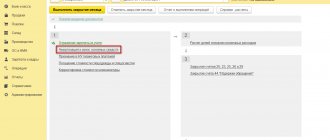Account 57 “Transfers in transit” is used by legal entities and individual entrepreneurs to collect information about funds that have been transferred for depositing into bank accounts, but have not yet been credited to them.
Account 57 in accounting is a collective summary of information about the company’s funds in transit, both in Russian rubles and foreign currency. As a rule, this account displays information about the delivery of cash to the bank (for example, trade proceeds), which has already been deposited in the cash desks of credit institutions or transferred through collection services, but has not yet been credited directly to the company's account. Confirmation of the transaction carried out are receipts from credit institutions for depositing money or copies of accompanying documentation from collectors.
To separate the method of depositing funds and separate accounting of transactions in foreign currency, account 57 can be divided into the following subaccounts:
57.01 – amounts that were deposited to credit institutions are displayed here, but confirmation of the deposit was not received by a bank statement (for example, delivery of trading proceeds);
57.02 – transactions for the acquisition of foreign currency, used when it is necessary to reflect in accounting the difference between the cost of acquiring currency and the exchange rate of the Central Bank of the Russian Federation;
Something to keep in mind! When including exchange rate differences in the costs of purchasing goods, it is recommended to use account 76.09.
57.03 – used in retail trade to display acquiring transactions (the buyer pays for goods through the terminal using payment cards, the acquiring bank credits the money after some time, deducting a certain percentage for making payments);
57.21 – transfer transactions expressed in foreign currency;
Attention! If necessary, the company may introduce additional subaccounts.
Account 57 is active - the debit displays the amounts deposited for crediting. For the loan account 57, further funds are credited for their intended purpose (receipt of money to the cash desk, receipt of currency, etc.)
Basic information
The “in transit” status is used when there is a gap between the date of official confirmation of the write-off and the date of crediting the money to the company’s account. Let's look at examples:
- Revenue that is placed in the cash register for subsequent transfer to the company's account. Only those revenues that have not yet been credited are considered.
- Currency placed in the cash register for placement on the company's account. Only foreign money that has not yet been credited is considered.
The basis for accounting for money is primary. These could be receipts, accompanying statements, etc.
FOR YOUR INFORMATION! Banks may issue statements prepared in an unofficial form. They indicate the amount of money that has already arrived in the company’s account, but this has not yet been recorded in documentation. Such amounts must be recorded in accounting as “transfers in transit.” The company has no right to dispose of this money until settlement papers confirming payment are received.
Let's summarize. Transfers lasting more than a day are recorded on account 57. DT reflects the amounts of transfers that have not yet arrived at the company’s account. According to CT, transfers are written off, arising on the basis of crediting to the company's account.
Account characteristics
Synthetic account 57 belongs to the group of active accounting accounts. Consequently, when a money transfer is sent to a DMC, a debit accounting entry is generated, and when money is credited to a DMC, a credit entry is generated.
The accounting provides subaccounts:
- 57-01 - information on transactions involving transfers of money in ruble equivalent is generated for this subaccount;
- 57-02 - subject to reflecting information on the movement of foreign currency in transit;
- subaccount 57-03 - summarizes information on operations performed using payment cards, that is, on acquiring operations.
Features of accounting
Account 57 is maintained on the basis of the current Chart of Accounts established by Order of the Ministry of Finance No. 94 of October 31, 2000. It corresponds with the following accounts: 50, 62, 79, 90-91 and others. Credit account 57 corresponds with accounts 50-52, 62, 73.
FOR YOUR INFORMATION! Maintaining account 57 is regulated by a number of regulatory documents. This, among other things, is the Directive of the Central Bank No. 3210 dated March 11, 2014.
Subaccounts of account 57 “On the way”
Subaccounts are needed for separate accounting of certain operations/actions. For example, these could be transactions with currency, depositing money in a certain way. Account 57 can be divided into these subaccounts:
- 01. Amounts sent to credit organizations are recorded here. These are transfers for which there is no confirmation yet in the form of a bank statement. Example – delivery of proceeds, collected funds. That is, money transferred to a bank account through collectors.
- 02. Actions to purchase currency. A subaccount is needed when there is a need for a difference between the purchase price and the Central Bank exchange rate.
- 03. The sub-account is used in trading to record acquiring transactions. For example, products are paid for through the terminal using special cards. In this case, the money will be credited to the company’s account account after some time. In this case, the owner of the terminal takes a percentage for the transfer.
- 21. Actions performed in currency.
If required, the accountant can create auxiliary subaccounts.
Credit and debit account 57
Account 57 is considered an active balance account. Its features are in two areas:
- Debit. Money allocated for enrollment.
- Credit. Subsequent transfer of money for its original purpose. In particular, this is the posting of funds to the cash desk, the receipt of money in foreign currency.
Postings are used to reflect certain transactions. They record certain actions/operations.
Standard postings to account 57
Entries on account 57 can be very diverse. However, we can highlight the most commonly used wiring:
- DT57/01 KT50. Revenue comes to the company's account with the bank at the end of the month. Primary – bank receipt.
- DT50-52 KT57. The money “on the way” arrived at the cash desk/banking institution.
- DT57/02 KT50. Directing proceeds to a banking institution through collectors.
- DT51 KT57/02. The money is credited to the account through the collection service.
- DT57/03, 04 KT51,52. Transfer of money for the purchase/sale of currency.
- DT57 KT62.76. Transfer from a debtor to pay a debt that has not yet been credited. When this transfer arrives at the company's account, you need to post it back.
Each entry is made on the basis of the primary document. As a rule, these are bank papers (receipts, etc.). Let's look at the wiring that is used in specific situations.
Receipt of money to the company's bank account
When money is received into the account, these entries are used:
- DT50 KT90/01. Company revenue.
- DT57/02 KT50. Money accepted by the collector.
- DT51 KT57/02. The money is credited to the company's account.
- DT91/02 KT51. Bank commission for money transactions.
As is obvious, a subaccount appears in almost every posting. It is needed to detail the operation.
Acquiring accounting
Acquiring is payment by payment cards, that is, non-cash. Such transactions are reflected in accounting using these entries:
- DT50 KT90. The proceeds have been credited to the account.
- DT57 KT90. Fixation of revenue by bank transfer.
- DT90/03 KT68. VAT accrual on sales.
- DT51 KT57. Receipt of money by bank transfer, taking into account bank commission.
- DT91 KT57. Fixation of bank commission for non-cash payments.
The accountant must take into account the fact that the transactions were carried out in a non-cash manner.
Purchasing currency
The company can purchase foreign currency. In this case, the following wiring is used:
- DT57 KT51. Transfer of money for the purchase of currency.
- DT52 KT57. The currency was converted and credited to the organization’s account.
- DT57 KT91/01. Fixing a positive exchange rate difference.
- DT91/02 KT57. Fixing a negative difference between courses.
Primary documentation: accounting certificate, bank statements.
FOR YOUR INFORMATION! The primary document is needed to confirm the amounts recorded in the accounting records.
What is it used for in accounting - briefly
As mentioned earlier, accounting account 57 is considered transit. Accordingly, many organizations often refrain from using it in accounting practice, avoiding excessive complexity of the current accounting system. However, the feasibility of its use is determined by the time duration of a particular money transfer.
Thus, account 57 may not be used by enterprises operating under the following circumstances:
- A cash register is not used to receive and spend funds. All transactions are non-cash and are performed exclusively through the company's bank account. Alternatively, all cash received by the company may not be transferred to the servicing bank, but may be immediately used for its intended purpose.
- The money received by the organization is used to finance travel expenses, make payments to suppliers, pay salaries to employees and other purposes.
- If sales revenue is characterized by small volumes, and the amount of cash does not exceed the daily limit.
Typical examples of such operations include the following situations:
- Cash is sent to the cash desk of a savings institution or postal organization for the purpose of further transfer of the corresponding funds to the account of the counterparty (supplier) in the bank.
- At the end of the working (operating) day, the cash is handed over to the cash desk of the financial institution or, alternatively, transferred to the collector.
- The business entity transferred its own funds from one bank foreign currency account to another, from a current bank account to an account in foreign currency, or vice versa (for a situation where the organization has several accounts).
- If a business entity has a corporate bank card in one financial institution, and an account for making payments in another bank, the amount of money transferred by the company from the r/account to this plastic card is subject to reflection in the 57-account.
Subaccounts
In order to differentiate the methods of depositing money and ensure separate accounting of transactions in foreign currency, it is recommended to allocate the following sub-accounts within the synthetic 57 account:
- Subaccount 57.01 – amounts of money that have already been deposited into the cash desk of a financial institution are recorded, but for which, however, the fact of their crediting to the account of the given entity has not yet been confirmed. This is a typical situation when handing over sales proceeds to the servicing bank.
- Subaccount 57.02 – transactions related to the purchase of foreign currency are reflected. It is used in situations where it is necessary to take into account the difference between the purchase rate of the corresponding currency and the current rate of the Central Bank of the Russian Federation.
- Subaccount 57.03 – acquiring transactions are recorded in retail trade. Using the terminal, the buyer pays for the purchased goods with a payment plastic card. The acquiring bank, accordingly, credits the paid money to the seller after some time. In this case, the acquiring bank withholds a specific commission from the credited amount.
- Subaccount 57.21 – reflects remittances of a business entity in foreign currency.
- Other subaccounts allocated by the organization if necessary.
Debit records the amounts of money transferred by the organization for subsequent crediting for a specific purpose.
The loan reflects operations of targeted transfer of this money (for example, receipt of currency, replenishment of the cash register with cash, other operations).
Reflection of transfers in transit in the balance sheet
Money stuck in account 57 is recorded in the balance. In particular, the funds are reflected in Art. “Other money” balance sheet. This item is included in the group "Cash". The latter is recorded on line 1259 of the Balance Sheet. Transfers in transit must be reflected on the reporting date.
FOR YOUR INFORMATION! It makes sense to fix the procedure for reflecting transfers en route in the balance sheet in the accounting policy.
Application
Good afternoon, Anna. Let's take a closer look: When purchasing currency, you draw up documents (assume that the Central Bank of the Russian Federation exchange rate is 71 rubles, the bank rate is 72 rubles): 1. Debit from the current account Type of transaction - Other settlements with counterparties, postings to you: Dt 57.02 Kt 51 - 5,800,000 rubles (Write-off of funds for the purchase of foreign currency) 2. Receipt to the current account type of transaction Purchase of foreign currency, posting from you: Dt 52 Kt 57.02 - 5,680,000 rubles. (80,000 EUR) Dt 91.02 Kt 57.02 - 80,000 rub. ((71 rubles - 72 rubles) * 80,000 EUR) There is a balance remaining on Dt 57.02 in the amount of 40,000 rubles. (5,800,000 rub. - 5,680,000 rub. - 80,000 rub.) 3. Return of unused amount - document Receipt to the current account type of transaction Other settlements with counterparties: Dt 51 Kt 57.02 - 40,000 rub.
Now analyze: 1. if you have a bank rate and the rate of the Central Bank of the Russian Federation is not different, then you will not be able to post Dt 91.02 Kt 57.02 (Dt 57.02 Kt 91.01) see screenshot 2. Perhaps the balance on account 57.02 in the amount of 16477.66 is exactly Is there a balance that needs to be returned (clause 3)?
Details
According to the rules for filling out the company’s reports, at the end of the year, generalized information about all the company’s existing financial flows, both for transactions with cash, foreign currency, and non-cash transfers, and actions with cash equivalents, is entered in line 1250 of the balance sheet.
The company's funds can be presented in both cash and non-cash form. The balance sheet displays the following basic information:
- cash balance in the cash register on a given date, incl. in foreign currency;
- balances on the company's current accounts;
- money denominated in foreign currency and stored in various foreign currency accounts;
- other funds (for example, transfers in transit or funds in special accounts).
Note from the author! If there is a currency for inclusion in the balance sheet, it is recalculated at the current exchange rate of the Central Bank of the Russian Federation established as of the reporting date.
When making cash payments, according to the law, it is necessary to set a limit on the cash balance. Amounts in excess of the limit are credited to the organization's current account. When filling out reports on the availability of financial assets, the balance in the company’s bank accounts must fully correspond to the ordered extract from the banking institution on the availability and flow of funds on a given date.
In addition to the company's cash, line 1250 of the financial statements records information about available cash equivalents.
Cash equivalents, according to accounting rules, are highly liquid financial investments that can be easily converted into a predetermined amount of cash. Additionally, they are characterized by the presence of minimal risk of price changes, which distinguishes them from other short-term and long-term financial investments.
Examples of cash equivalents:
- deposits in credit institutions on demand (the ability to receive the invested amount at any time, but a minimum interest rate on the deposit);
- financial investments, for example, in securities for the purpose of their prompt resale (within 3 calendar months).
Line 1250 of the balance sheet – current assets of the company. Information is indicated here as of the reporting date of the current year, the previous year and the one preceding the previous one. An increase in the indicator positively characterizes the financial condition of the enterprise, but a comprehensive analysis of the reporting lines should be carried out (the cash indicator can be increased through loans and borrowings).
Note from the author! Explanations for the indicators included in line 1250 are displayed in the company's cash flow statement.
Using account 57
Conducting activities without using the 57 account may not always reliably reflect the financial situation of the enterprise. The money may not be used for its intended purpose and may be returned to the company's cash desk. Or lost or stolen after delivery to the responsible person or collector.
That is why accounting using account 57 is methodologically more correct.
Account 57 “Transfers in transit” is an active balance sheet account; receipts are reflected in Dt, and debits are reflected in Ct.
The account is used as a transit account in the following cases:
- transferring money at the end of the day from the cash register or to collectors;
- movement of funds between foreign currency accounts of one organization or foreign currency and current accounts;
- corporate plastic card of one bank with an account in another bank, etc.
Example of typical postings
Galaxy LLC is engaged in retail trade. The daily proceeds in the amount of 45,000 rubles were issued to the collectors for transfer to the bank. While sorting the cash, the collector discovered a counterfeit 1,000 ruble bill. Therefore, the next day the amount of 44,000 was credited to the store’s account.
Postings
| Dt | CT | Operation description | Sum | Document |
| 57 | 50 | The funds were transferred to the collector | 45000 | Transmittal sheet, RKO |
| 51 | 57 | DS transferred by the collector to a bank account | 44000 | Bank statement |
| 94 | 57 | The amount of the shortfall is recorded | 1000 | Accounting information |
Using account 57 in foreign exchange transactions
If the operations of debiting rubles from an account, selling currency and crediting proceeds take more than one day, account 57 must be used.
Example of transactions when purchasing currency
Master LLC submitted an application to the bank to purchase currency and for these purposes transferred 600,000 rubles to it. The bank purchased currency on the stock exchange at a price of 60 rubles per dollar. The Central Bank exchange rate on this date was 58 rubles per dollar.
Postings
| Dt | CT | Operation description | Sum | Document |
| 57 | 51 | DS for currency purchases are listed | 600000 | Bank statement |
| 52 | 57 | The purchased currency is credited to the account (10,000 USD * 58 rubles per USD) | 580000 | Bank statement |
| 91 | 57 | The difference between the Central Bank rate and the acquisition rate is reflected ((60 rubles per USD -58 rubles per USD)*10000) | 20000 | Bank statement |
Example of an operation when selling currency
On October 1, Master LLC submitted an order to the bank to sell $1,000 on October 2. The Central Bank dollar exchange rate as of October 2 is 60 rubles/USD. On October 2, the bank sold the currency at the rate of 61 rubles/USD.
Postings:
| Dt | CT | Operation description | Sum | Document |
| 57 | 52 | The currency to be sold has been written off (at the Central Bank rate) | 60000 | Bank statement |
| 51 | 57 | The sales amount is credited at the bank rate (1000 * 61 rubles/USD) | 61000 | Bank statement |
| 57 | 91 | Other income reflected (exchange difference) | 1000 | Bank statement |
Acquiring operations
Acquiring is payment by bank card through an electronic payment terminal.
Postings for electronic payment
| Dt | CT | Operation description | Sum | Document |
| 57 | 90 | Sales revenue received | 25000 |
Postings if necessary, specifying the buyer
| Dt | CT | Operation description | Sum | Document |
| 57 | 62 | Receiving payment from the buyer | 1500 | Cash receipt |
| 57 | Receipt of proceeds to the current account | 1500 | Bank statement | |
| 91 | The commission of the acquiring bank is written off | 9 | Bank statement |
Accounting account 57: features of use
Often, when transferring money (depositing cash to a bank, withdrawing funds from a current account), accountants do not use account 57. The procedure ends with one of the possible entries:
- Debit 50 ― Credit 51 ― cash withdrawal from the current account;
- Debit 51 - Credit 50 - depositing revenue or other funds into a bank account.
However, a time gap often forms between the two final points of receipt/transfer of money. The transfer of assets may not occur on the same day, for example, if cash was withdrawn from the cash register at the end of the working day, and it was credited to the current account at the beginning of the next.
| ★ Best-selling book “Accounting from scratch” for dummies (understand how to do accounting in 72 hours) > 8,000 books purchased |
| ★ Best-selling book “Accounting from scratch” for dummies (understand how to do accounting in 72 hours) > 8,000 books purchased |
Example. At the end of the day 02/01/2016, revenue in the amount of 67,000 rubles was capitalized to the organization. 20,000 was left in the cash register for distribution to accountable persons for current household expenses. Other money must be transferred to the current account without violating the cash register limit (30,000 rubles). What transactions reflect these actions?
Debit 50 - Credit 62 (67,000 rubles) - receipt of revenue for goods sold to the enterprise's cash desk.
Debit 71 - Credit 50 (20,000 rubles) - funds were issued to the accountable person.
Debit 57 - Credit 50 (47,000 rubles) - money was transferred to the collection service to replenish the current account.
Debit 51 - Credit 57 (47,000 rubles) - yesterday's revenue of the enterprise was credited to the bank account.
Using account 57 allows you to maintain cash discipline by depositing funds into your current account as they arrive.
In addition, a simple posting of Debit 50 - Credit 51 cannot always reflect the actual financial condition. The money may ultimately not be used for its intended purpose, for example, returned back to the company’s cash desk. We cannot exclude the possible occurrence of force majeure circumstances - theft, loss of cash after acceptance by collection services. In such cases, cash flow does not achieve the ultimate goal - replenishing the current account.
Bank receipts and copies of accompanying statements issued to collection services are considered the basis for accepting funds into account 57.
Account 57 in accounting. Transfers within the organization
To reflect cash flow, revenue for goods sold, and money transfers, account 57 is used in organizations for the following purposes:
- Topping up your current account. Funds are transferred to the organization's employees or collection services for crediting to the bank through the organization's cash desk.
- Cash withdrawal. Based on the issued bank receipt, funds can be credited to account 57 before the cash is posted to the cash desk.
- To transfer funds to the enterprise’s corporate card from current bank accounts.
- For acquiring operations.
Currently, the possibility of paying for goods by individuals using payment terminals is widespread. This form of payment is relevant not only for regular stores, but also for making purchases online.
Organizations using such methods, in addition to having specialized equipment, enter into agreements with banks for servicing payment terminals - acquiring. An authorized bank, an intermediary (acquirer), installs its own payment terminals in the institution, through which the population makes payments for purchased goods.
In such cases, funds are not immediately credited directly to the organization. The 57 count should also be used here.
Debit 57 - Credit 90 (36,000 rubles) - revenue from customer cards is reflected.
Debit 90 - Credit 68 (5491.53 rubles) - accrual for VAT sales.
Debit 51 – Credit 57 (35,460 rubles) – receipt of funds to the institution’s current account.
Debit 91 - Credit 57 (540 rubles) - bank expenses under the acquiring agreement.
If an organization is a VAT payer, tax must be charged on the full amount of revenue.
Read more about the accounts used in transactions in the articles: account 68 (accounting for calculations of taxes and fees), account 90 (accounting for the sale of finished products), account 91 (accounting for other income and expenses).
| ★ Best-selling book “Accounting from scratch” for dummies (understand how to do accounting in 72 hours) > 8,000 books purchased |
Reflection of account balances 57 on balance sheet accounts
In order to calculate the liquidity ratios of an enterprise (current, urgent), use the data from line 1250 of the balance sheet, called “Cash and cash equivalents”. Using these ratios, information is provided about the possibility of repaying the subject's current short-term obligations using its own funds. Cash and short-term financial investments are recognized as liquid assets.
Composition of line 1250 balance
| Balance section | Account debit | What is it formed from? |
| Current assets | Debit 50 | Cash on hand |
| Current assets | Debit 51 | Account balances |
| Current assets | Debit 52 | Currency bank accounts |
| Current assets | Debit 55 | Special accounts - deposits, letters of credit |
| Current assets | Debit 57 | Amounts of transferred money transfers that did not reach their destination |
| Current assets | Debit 58 | Cash equivalents of short-term financial investments (bills and other securities) |
| Current assets | Debit 76 | Other cash equivalents of short-term financial investments |
The total value of the listed indicators gives an idea of the content of line 1250 of the balance sheet. Cash in transit helps to reflect the actual picture of the financial condition of the enterprise at a particular moment, preventing assets from getting lost due to time intervals between the issuance of cash and crediting for its intended purpose.
But high performance here is not always seen as a positive sign. Rather, it means that the organization’s money is not working. A well-developed monetary policy of an institution should create conditions not only for the speedy repayment of obligations, but also for the timely investment of funds into circulation, bringing additional profit to the enterprise.
Rate the quality of the article. We want to become better for you: If you have not found the answer to your question, then you can get an answer to your question by calling the numbers ⇓ Free legal advice Moscow, Moscow region call
One-click call St. Petersburg, Leningrad region call: +7 (812) 317-60-16
Call in one click From other regions of the Russian Federation, call
One-click call







